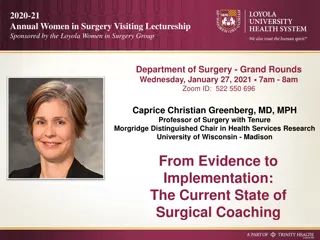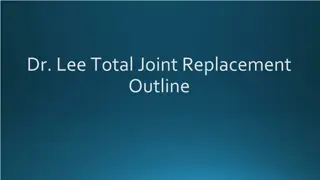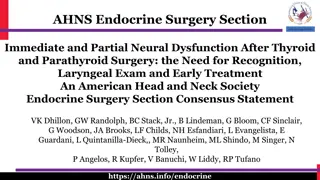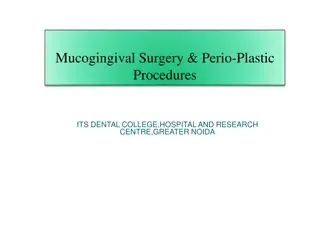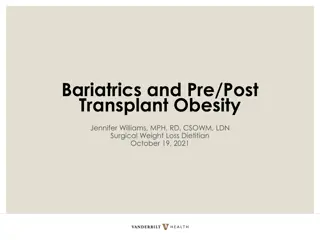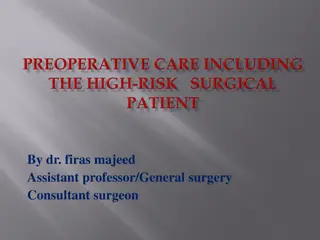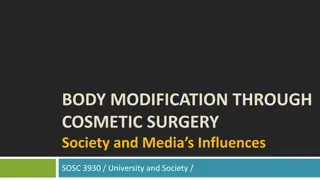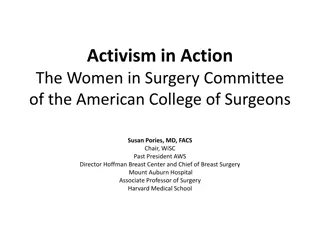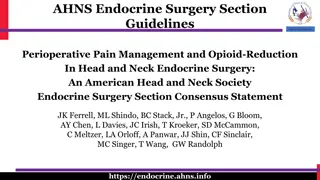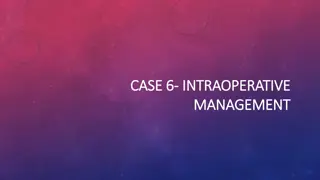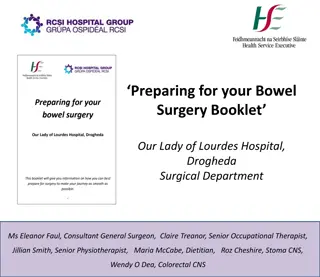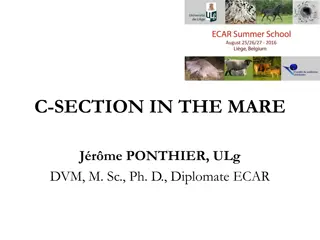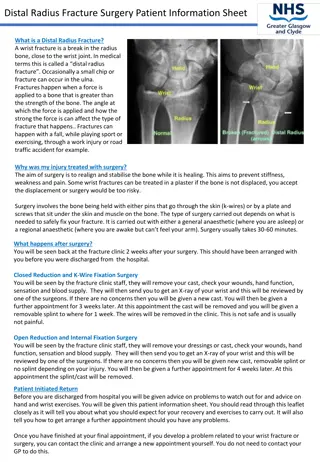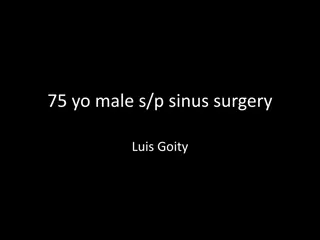Guidelines and Instructions for Preparing for Surgery
Learn about important pre-surgery instructions including medication considerations, fasting rules, and what to do the day before and on the day of surgery. Understand the importance of proper preparations to ensure a smooth and successful surgical experience.
Uploaded on Oct 08, 2024 | 0 Views
Download Presentation

Please find below an Image/Link to download the presentation.
The content on the website is provided AS IS for your information and personal use only. It may not be sold, licensed, or shared on other websites without obtaining consent from the author. Download presentation by click this link. If you encounter any issues during the download, it is possible that the publisher has removed the file from their server.
E N D
Presentation Transcript
SURGERY MRS JENN SUMMER SEMESTER NU220 MEDICAL SURGICAL NURSING PART 1
PRE OP INSTRUCTIONS MEDICATIONS THAT MUST BE CONSIDERED PRIOR TO SURGERY non-prescription medicines, vitamins, herbs, or supplements, aspirin, aspirin containing compounds, Coumadin, Pradaxa or Plavix impair the body's ability to form a clot and stop bleeding If you have diabetes and take insulin or another diabetes medicine, instructions will be provided on how to adjust your medicine on the day of surgery when you will not be eating. The Day Before Surgery Do not shave near your surgical site. Shaving can irritate your skin, which may lead to infection. Do not smoke on the day before surgery. This is irritating for your lungs. Do not eat any solid food or drink any liquids as instructed at the time of your interview. This includes water, candy, and chewing gum.
PRE OP INSTRUCTIONS The Day of Surgery If you've been asked to take routine or other medicines on the morning of surgery, please take them with a very small sip of water. Wear loose and comfortable clothing and flat shoes. Leave jewelry and valuables at home. If you wear contact lenses, please bring your glasses with you. Please remove any body piercings. Because of urgent cases, there may be a delay in the start of your surgery or, your start time could be earlier than expected if last minute cancellations occur. If possible, bring something to read and arrive early. If you receive general anesthesia, you will be taken to the Recovery Room for approximately one hour after your procedure. If you are going to be discharged from the hospital after surgery, you will be allowed to go home when you are fully alert. You will not be allowed to drive yourself home. Please make arrangements for someone to take you home.
PRE OP FASTING RULES The after-midnight order has been the norm for decades. It's a precautionary measure to prevent pulmonary aspiration, which occurs when stomach contents enter the lungs, potentially blocking airflow and putting patients at risk for serious infections like pneumonia. However, modern anesthesia techniques make pulmonary aspiration much less likely. And when it does happen, it almost never results in long-term complications or death. What's more, research has demonstrated that the stomach empties much faster than previously believed, and a long fasting period probably won't reduce aspiration any better than a short fast. A long fast may add to discomfort during recovery. Fasting can lead to headaches, nausea, dizziness and dehydration. Dehydration can be serious and makes it difficult for nurses to draw blood for necessary tests. In its preoperative fasting guidelines, the American Society of Anesthesiologists says it's safe for healthy people of all ages who undergo elective surgery to consume: Clear liquids, including water, clear tea, black coffee, carbonated beverages and fruit juice without pulp, up to two hours before surgery Very light meals, like toast and tea with milk, up to six hours before surgery Heavy meals, including fried or fatty foods and meat, up to eight hours before surgery
LONGER FASTING PERIODS for GERD or DM GASTRIC PARALYIS CLIENTS Some GERD patients do need to follow the after-midnight rule because they must FAST LONGER than normal standard pre-op surgery recommendations. Why? The fasting rules vary for gastroesophageal reflux disease (GERD) and people with gastric paresis (paralysis of the stomach that can occur in people who have diabetes). These individuals have an increased risk of vomiting and aspiration during surgery and should be instructed to fast for a longer period as should people undergoing gastric or intestinal surgeries. A blanket after-midnight order protects people who might have undiagnosed GERD or diabetes. PROBLEM- The longer a Diabetic client fasts; the higher risk of hypoglycemic crisis occurring. So its very important that nurse monitor blood sugar glucose levels closely.
POST OP INSTRUCTIONS Pain After Surgery Most patients experience discomfort after the anesthesia wears off. Some experience pain and nausea and others have minimal soreness. Patients may be asked to rate their pain on a 1 10 scale to determine their level of discomfort. Slight pain is 1 2; annoying pain, 3 4; significant pain, 5 6; severe pain, 7 8; and excruciating pain, 9 10. JCAHO Time sequential charting Nurse has 0-30minutes to respond to a complaint of PAIN Assess 30 min after IV or Transdermal Pain Med Assess 60 min after PO or Injection Pain Med
BREAST CANCER SURGERIES Lumpectomy, also known as breast-conserving surgery, is the removal of only the tumor and a small amount of surrounding tissue. Mastectomy is the removal of all of the breast tissue. Mastectomy is more refined and less intrusive than it used to be because in most cases, the muscles under the breast are no longer removed. Lymph node removal, or axillary lymph node dissection, can take place during lumpectomy and mastectomy if the biopsy shows that breast cancer has spread outside the milk duct. Some people qualify for the less-invasive sentinel lymph node dissection. Breast reconstruction is the rebuilding of the breast after mastectomy and sometimes lumpectomy. Reconstruction can take place at the same time as cancer-removing surgery, or months to years later. Some women decide not to have reconstruction or opt for a prosthesis instead. Prophylactic mastectomy is preventive removal of the breast to lower the risk of breast cancer in high-risk people. Prophylactic ovary removal is a preventive surgery that lowers the amount of estrogen in the body, making it harder for estrogen to stimulate the development of breast cancer. Cryotherapy, also called cryosurgery, uses extreme cold to freeze and kill cancer cells. Right now, cryotherapy is an experimental treatment for breast cancer.
MYOMECTOMY Myomectomy is the surgical removal of uterine fibroids without the removal of the uterus. There are several techniques that may be used, and the choice of the technique depends on the location and size of the fibroids as well as the characteristics of the woman. It is sometimes impossible to remove all the fibroids, and new fibroids may grow after a myomectomy. Though myomectomy is the only accepted procedure for fibroids in a woman who wants to maintain fertility, a myomectomy may lead to scarring that can negatively affect future fertility. Following a myomectomy, cesarean delivery is frequently recommended to prevent the myomectomy scar from breaking open during labor. Types of myomectomies include: Laparoscopic myomectomy (removal of uterine fibroids) Abdominal myomectomy Hysteroscopic myomectomy
HYSTERECTOMY Hysterectomy is a surgery to remove the uterus. It prevents future pregnancy and eliminates fibroid-related bleeding and pressure symptoms. There are two categories of hysterectomy: Total hysterectomy is removal of the entire uterus, including the cervix (the lower part of the uterus) Vaginal hysterectomy Laparoscopic total hysterectomy (removal of uterus and cervix) Robot-assisted laparoscopic hysterectomy Abdominal hysterectomy Laparoscopic supracervical hysterectomy is removal of the upper part of the uterus, but not the cervix. This type of surgery is not recommended for women with a history of an abnormal Pap smear or certain types of pelvic pain. Up to 5- 10% of women may continue to have chronic cyclic bleeding after surgery, similar to a period. It was previously thought that a supra-cervical hysterectomy would preserve sexual function better than a total hysterectomy, but research does not support this theory. Benefits to supra-cervical hysterectomy include slightly faster surgery and shorter recovery time.
ANGIOPLASTY Also known as Percutaneous Coronary Interventions [PCI], Balloon Angioplasty and Coronary Artery Balloon Dilation. What the Procedure Does Special tubing with an attached deflated balloon is threaded up to the coronary arteries. The balloon is inflated to widen blocked areas where blood flow to the heart muscle has been reduced or cutoff. Often combined with implantation of a stent to help prop the artery open and decrease the chance of another blockage. Considered less invasive because the body is not cut open. Lasts from 30 minutes to several hours. Often requires an overnight hospital stay. Reason for the Procedure Greatly increases blood flow through the blocked artery. Decreases chest pain (angina). Increases ability for physical activity. Reduces risk of a heart attack. Can also be used to open neck and brain arteries to help prevent stroke.
LASER ANGIOPLASTY What the Procedure Does Similar to angioplasty except that the catheter has a laser tip that opens the blocked artery. Pulsating beams of light vaporize the plaque buildup. Reason for the Procedure Increases blood flow through blocked arteries.
BYPASS CABG CABBAGE OPEN HEART SURGERY Also known as CABG or "cabbage," Coronary Artery Bypass Graft and Open-Heart Surgery What the Procedure Does Treats blocked heart arteries by creating new passages for blood to flow to your heart muscle. It works by taking arteries or veins from other parts of your body called grafts and using them to reroute the blood around the clogged artery. A patient may undergo one, two, three or more bypass grafts, depending on how many coronary arteries are blocked. Requires several days in the hospital. Reason for the Procedure One of the most common and effective procedures to manage blockage of blood to the heart muscle. Improves the supply of blood and oxygen to the heart. Relieves chest pain (angina). Reduces risk of heart attack. Improves ability for physical activity.
HEART TRANSPLANT What the Procedure Does Removes a diseased heart and replaces it with a healthy human heart when a heart is irreversibly damaged. Uses hearts from organ donation. Reason for the Procedure Recognized as a proven procedure to restore heart health in appropriately selected patients
KIDNEY TRANSPLANT: Post diagnosis of ESRD or CRF Living Related Donor Unknown donor
STENT PLACEMENT What the Procedure Does A stent is a wire mesh tube used to prop open an artery during angioplasty. The stent stays in the artery permanently. Reason for the Procedure Holds the artery open. Improves blood flow to the heart muscle. Relieves chest pain (angina).
TRANSMYOCARDIAL REVASCULARIZATION (TMR) What the Procedure Does An incision is made on the left breast to expose the heart. Then, a laser is used to drill a series of holes from the outside of the heart into the heart's pumping chamber. In some patients TMR is combined with bypass surgery. In those cases an incision through the breastbone is used for the bypass. Usually requires a hospital stay. Reason for the Procedure Used to relieve severe chest pain (angina) in very ill patients who aren't candidates for bypass surgery or angioplasty.
COLON SURGERY: COLECTOMY Colectomy is a surgical procedure to remove all or part of the colon. When only part of the colon is removed, it is called a partial colectomy. The procedure is also known as a bowel resection. The colon is part of the body's digestive system. The digestive system removes and processes nutrients ( vitamins, minerals, carbohydrates, fats, proteins, and water) from foods and helps pass waste material out of the body. The digestive system is made up of the esophagus, stomach, and the small and large intestines. RISKS ASSOCIATED WITH COLECTOMY include: Bleeding Deep Vein Thrombosis (blood clots in the legs) Pulmonary embolism (blood clots in the lungs) Bowel obstruction caused by scar tissue as a result of surgery Infection Injury to bladder, small intestines and other nearby organs Tears in sutures that were used to reconnect portions of the digestive system
COLON SURGERY: PROCTOCOLECTOMY P is the surgical removal of colon and rectum. This is the standard surgical procedure for patients with ulcerative colitis where medical therapy has failed or serious life-threatening complications have ensued. Proctocolectomy is followed by either: #1 - Ileal Pouch Anal Anastomosis (Restorative Proctocolectomy) This procedure preserves part of the anus, which allows the patient to have normal bowel movements. The surgeon removes the diseased part of the colon and the inside of the rectum, leaving the outer muscles of the anus. The surgeon then creates a pouch from the end of the ileum and attaches it to the inside of the anus. Waste is stored in the pouch and passed through the anus in the usual manner. Bowel movements may be more frequent and watery than before the procedure and inflammation of the internal pouch is a possible complication. This is known as pouchitis #2 Ileostomy Stoma pouch worn 24/7
COLON SURGERY: HEMORRHOIDECTOMY A hemorrhoidectomy is surgery to remove internal or external hemorrhoids that are extensive or severe A hemorrhoidectomy is performed in the following settings: Symptomatic grade III, grade IV, or mixed internal and external hemorrhoids Where there are additional anorectal conditions that require surgery Strangulated internal hemorrhoids Some thrombosed external hemorrhoids Where patients who cannot tolerate or fail minimally invasive procedures Types of hemorrhoidectomies and related procedures performed during surgery: Closed Hemorrhoidectomy Open Hemorrhoidectomy Stapled Hemorrhoidectomy (Procedure for Prolapse and Hemorrhoids - PPH) Rubber band Ligation Lateral Internal Sphincterotomy
PEG FEEDING TUBES Through the endoscope, your physician will view the stomach lining to determine the PEG tube insertion site. A small incision is made in the abdominal wall where the PEG tube will exit. The procedure lasts from 30 to 45 minutes.
J-TUBE FEEDING TUBE When a permanent tube will be used, the primary type used for gastroparesis is a J- tube (jejunal). J-tubes are placed directly into the small intestine, and can be placed either percutaneously, laparoscopically, or surgically via a laparotomy. Feedings can be started at a slow rate within 4-12 hours after the procedure. Jejunal feedings are administered around-the-clock through a pump. Depending on the caloric needs of a patient, and whether or not he/she is able to take in supplemental nutrition orally, feeds might be limited to overnight, or a certain number of hours a day. Portable pumps and backpacks are availabl Surgical placement of a J-tube requires a hospital stay of at least 3 days. Feedings are not usually started for 24 hours, which allows the small bowel to awaken following anesthesia. The feeding rate is usually started off slowly, and gradually increased. The patient is released once an adequate feeding rate is achieved. All patients with feeding tubes are placed under the care of a home health agency which can provide feeding pumps, supplies, and instruction in their use.e, making it possible for a patient to be active and mobile.
IV THERAPIES FOR SURGERY #1 NaCl+ --- normal saline (0.9% sodium chloride) #2 LR ---Ringer s lactate **These fluids are sometimes referred to as crystalloids. Alternatives are the so-called plasma expanders or colloids. USED FOR: (a) Increasing BP (b) Treating hypovolemia (c) Treating shock
IV THERAPIES FOR SURGERY 5% glucose (dextrose) is widely used as a maintenance fluid (a substitute for patients unable to drink water). It has no place in the restoration of circulating volume because it is rapidly distributed throughout the entire body water component of about 40 litres. Avoid fluids containing dextrose during resuscitation.
NURSING ASSESSMENT OF FLUID INTAKE DURING SURGERY More important PRIORITY OF NURSE when surgical volume of replacement fluids is being administered is to observe the patient s response to volume infusion. The signs that the nurse has given adequate IV fluids and can slow the infusion are: 1) IF CLIENT S LOW BP COMES UP 2) IF CLIENT S TACHYCARDIA SLOWS 3) IF CLIENT S JUGULAR VENOUS PRESSURE RISES 4) IF CLIENT S URINE STARTS TO FLOW OUT
NURSING ROLE versus- CLIENT BP WHAT BLOOD PRESSURE SHOULD YOU AIM FOR? Depending on circumstances (such as if the patient is chronically dehydrated or debilitated), it may be preferable to get the blood pressure up to about 90 mmHg systolic over an hour or so before going into the operating room. On the other hand, an actively bleeding patient (for example, from a ruptured uterus, bleeding peptic ulcer, oesophageal varices, ruptured ectopic pregnancy, severed artery or other severe trauma) should have volume replacement, ketamine anaesthesia, tracheal intubation and surgery all at the same time. In severe haemorrhage, control of bleeding is the first priority, whatever the blood pressure or haemoglobin. If blood is haemorrhaging from one end of a patient, there is little point in pouring fluids in at the other end in the expectation that the blood pressure will come up. The only option is to rush the patient to the operating room and get surgical haemostasis.




